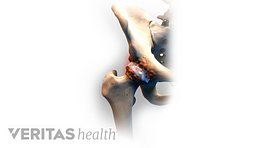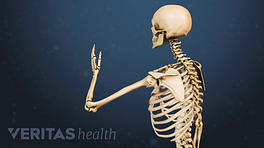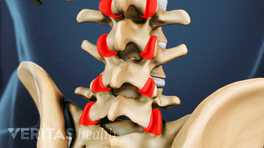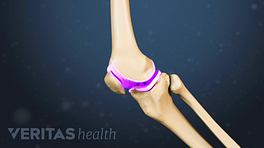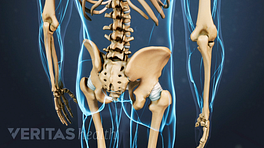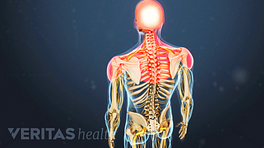There is no single underlying cause of osteoarthritis, which is the leading cause of joint degeneration and pain. There are several known risk factors that increase the likelihood of developing the disease. The more risk factors a person has, the more likely it is that they will develop osteoarthritis.
In This Article:
Osteoarthritis Risk Factors
While many risk factors cannot be changed, others, such as weak muscle tone, can be improved. Understanding the risk factors and making changes where possible may decrease the likelihood of developing or worsening osteoarthritis.
Factors known to increase susceptibility to osteoarthritis include:
Advanced age
The single most common cause of osteoarthritis is aging. Cartilage is likely to breakdown after decades of wear and tear. More recently, researchers have associated aging with low-grade inflammation and speculate that it may cause or exacerbate osteoarthritis. 1 Sanada F, Taniyama Y, Muratsu J, et al. Source of Chronic Inflammation in Aging. Front Cardiovasc Med. 2018;5:12. Published 2018 Feb 22. doi: 10.3389/fcvm.2018.00012 , 2 Gratal P, Lamuedra A, Medina JP, et al. Purinergic System Signaling in Metainflammation-Associated Osteoarthritis. Front Med (Lausanne). 2020;7:506. Published 2020 Aug 28. doi: 10.3389/fmed.2020.00506
Most people have signs of arthritis in one or more joints by age 50 or 60 3 Berlin A, Simon D, Tascilar K, Figueiredo C, Bayat S, Finzel S, Klaus E, Rech J, Hueber AJ, Kleyer A, Schett G. The ageing joint-standard age- and sex-related values of bone erosions and osteophytes in the hand joints of healthy individuals. Osteoarthritis Cartilage. 2019 Jul;27(7):1043-1047. doi: 10.1016/j.joca.2019.01.019. Epub 2019 Mar 16. PMID: 30890457. , 4 Eubanks JD, Lee MJ, Cassinelli E, Ahn NU. Does lumbar facet arthrosis precede disc degeneration? A postmortem study. Clinical Orthopaedics and Related Research 2007; 464:184-189. doi: 10.1097/BLO.0b013e3181583d4e As cited in Almeer G, Azzopardi C, Kho J, Gupta H, James SL, Botchu R. Anatomy and pathology of facet joint. J Orthop. 2020;22:109-117. Published 2020 Apr 8. doi:10.1016/j.jor.2020.03.058 even if they do not experience pain.
Genetics
Similar to eye color, the likelihood of a person developing osteoarthritis is influenced by genetics. 5 Kalichman, L., Li, L., Kim, D.H., Guermazi, A., Berkin, V., O’Donnell, C.J., Hoffmann, U., Cole, R., Hunter, D.J., 2008. Facet joint osteoarthritis and low back pain in the community-based population. Spine (Phila. Pa. 1976). 33, 2560–2565. doi: 10.1097/BRS.0b013e318184ef95 , 6 Bashkuev M, Reitmaier S, Schmidt H. Relationship between intervertebral disc and facet joint degeneration: A probabilistic finite element model study. J Biomech. 2020;102:109518. doi: 10.1016/j.jbiomech.2019.109518 Certain genes may increase the likelihood of cartilage breaking down at a younger age.
Some genes may not contribute to osteoarthritis until they are “turned on” by a particular event or stimulus. For example, older age is associated with increased levels of inflammatory proteins in the body, and these proteins may turn on certain genes that accelerate the arthritic process. The study of the interaction between genes and environmental triggers is called epigenetics.
Genes also play a role in physical abnormalities that can increase the risk of osteoarthritis. For example, hip dysplasia—a condition in which the hip’s socket is abnormally shallow—can cause extra mechanical stress on the joint that leads to osteoarthritis.
Excess weight
Research has clearly shown that carrying excess weight increases the risk of osteoarthritis. This is true for two reasons:
- Weight-bearing joints experience more wear and tear. For example, during walking, the knees experience a compressive load that is about 3-4 times bodyweight. 9 D’Lima DD, Fregly BJ, Patil S, Steklov N, Colwell CW. Knee joint forces: prediction, measurement, and significance. Proceedings of the Institution of Mechanical Engineers Part H, Journal of Engineering in Medicine. 2012;226(2):95-102. doi: 10.1177/0954411911433372 , 10 Messier SP, Gutekunst DJ, Davis C, DeVita P. Weight loss reduces knee-joint loads in overweight and obese older adults with knee osteoarthritis. Arthritis Rheum. 2005 Jul;52(7):2026-32. PubMed PMID: 15986358. Over time, an excess load can take a toll on joints.
- Obesity is associated with low-grade, systemic (body-wide) inflammation, which may contribute to the development of osteoarthritis. 11 Sartori-Cintra AR, Aikawa P, Cintra DE. Obesity versus osteoarthritis: beyond the mechanical overload. Einstein (Sao Paulo). 2014;12(3):374–379. DOI: 10.1590/s1679-45082014rb2912 , 12 Rosen, C.J. Pathogenic mechanisms of obesity-induced osteoarthritis: new clues from old joints Osteoarthritis and Cartilage. April 2019. Volume 27, S15. DOI: https://doi.org/10.1016/j.joca.2019.02.007 , 13 Thijssen E, van Caam A, van der Kraan PM. Obesity and osteoarthritis, more than just wear and tear: pivotal roles for inflamed adipose tissue and dyslipidaemia in obesity-induced osteoarthritis. Rheumatology (Oxford). 2015 Apr;54(4):588-600. DOI: 10.1093/rheumatology/keu464 (Obesity is defined as a BMI ≥ 30.)
Obesity is even associated with the non-weight-bearing joints in the hand. 14 Carman WJ et al. Obesity as a risk factor for osteoarthritis of the hand and wrist: a prospective study. Am J Epidemiol 1994; 139: 119– 129. As cited in Leung GJ, Rainsford KD, Kean WF. Osteoarthritis of the hand I: aetiology and pathogenesis, risk factors, investigation and diagnosis. J Pharm Pharmacol. 2014 Mar;66(3):339-46. doi: 10.1111/jphp.12196. Epub 2013 Dec 13. Review. PubMed PMID: 24329488. , 15 Grotle M et al. Obesity and osteoarthritis in knee, hip and/or hand: an epidemiological study in the general population with 10 years follow-up. BMC Musculoskelet Disord 2008; 9: 132. As cited in Leung GJ, Rainsford KD, Kean WF. Osteoarthritis of the hand I: aetiology and pathogenesis, risk factors, investigation and diagnosis. J Pharm Pharmacol. 2014 Mar;66(3):339-46. doi: 10.1111/jphp.12196. Epub 2013 Dec 13. Review. PubMed PMID: 24329488.
Past injury and surgeries
Old injuries and past surgeries can lead to osteoarthritis years or even decades later. For example:
- Minor damage to cartilage due to an injury or surgery may go unnoticed but worsen over time.
- An injury can change the body’s biomechanics (such as favoring one leg) and puts excess strain on certain joints, making them more prone to arthritis.
Experts estimate that 12% of cases of osteoarthritis in the hip, knee, and ankle are due to traumatic injuries. 16 Brown TD, Johnston RC, Saltzman CL, Marsh JL, Buckwalter JA. Posttraumatic osteoarthritis: a first estimate of incidence, prevalence, and burden of disease. J Orthop Trauma. 2006 Nov-Dec;20(10):739-44. DOI: 10.1097/01.bot.0000246468.80635.ef
Joint stress and overuse
Occupations or sports that require repetitive motions over months or years can put increased stress on specific joints and increase one’s risk of developing osteoarthritis.
Sedentary lifestyle and weak muscle tone
Just as too much stress on a joint can cause arthritis, so can too little stress. For example, the knees must experience some weight-bearing stress to encourage cartilage tissue health. 17 Gardiner BS, Woodhouse FG, Besier TF, et al. Predicting Knee Osteoarthritis. Ann Biomed Eng. 2016;44(1):222–233. DOI: 10.1007/s10439-015-1393-5
In addition, a lack of exercise or a sedentary lifestyle can lead to muscle weakness. Weak muscles are unable to support a joint, resulting in more stress on the joint tissues, including cartilage and underlying bone. This stress can lead to osteoarthritis.
See Ways to Get Exercise When You Have Arthritis
In addition to the risk factors listed above, research has identified certain biochemical changes that occur in joints affected by osteoarthritis. 18 Van Spil WE, Nair SC, Kinds MB, Emans PJ, Hilberdink WK, Welsing PM, Lafeber FP. Systemic biochemical markers of joint metabolism and inflammation in relation to radiographic parameters and pain of the knee: data from CHECK, a cohort of early-osteoarthritis subjects. Osteoarthritis Cartilage. 2015 Jan;23(1):48-56. doi: 10.1016/j.joca.2014.09.003. Epub 2014 Sep 6. PubMed PMID: 25205017. It is not clear if these changes are a cause or effect of the osteoarthritis process.
The more risk factors a person has, the more likely they are to develop osteoarthritis. While risk factors can increase the chances of developing osteoarthritis, they are not absolute. It is possible to have several risk factors and never develop osteoarthritis.
- 1 Sanada F, Taniyama Y, Muratsu J, et al. Source of Chronic Inflammation in Aging. Front Cardiovasc Med. 2018;5:12. Published 2018 Feb 22. doi: 10.3389/fcvm.2018.00012
- 2 Gratal P, Lamuedra A, Medina JP, et al. Purinergic System Signaling in Metainflammation-Associated Osteoarthritis. Front Med (Lausanne). 2020;7:506. Published 2020 Aug 28. doi: 10.3389/fmed.2020.00506
- 3 Berlin A, Simon D, Tascilar K, Figueiredo C, Bayat S, Finzel S, Klaus E, Rech J, Hueber AJ, Kleyer A, Schett G. The ageing joint-standard age- and sex-related values of bone erosions and osteophytes in the hand joints of healthy individuals. Osteoarthritis Cartilage. 2019 Jul;27(7):1043-1047. doi: 10.1016/j.joca.2019.01.019. Epub 2019 Mar 16. PMID: 30890457.
- 4 Eubanks JD, Lee MJ, Cassinelli E, Ahn NU. Does lumbar facet arthrosis precede disc degeneration? A postmortem study. Clinical Orthopaedics and Related Research 2007; 464:184-189. doi: 10.1097/BLO.0b013e3181583d4e As cited in Almeer G, Azzopardi C, Kho J, Gupta H, James SL, Botchu R. Anatomy and pathology of facet joint. J Orthop. 2020;22:109-117. Published 2020 Apr 8. doi:10.1016/j.jor.2020.03.058
- 5 Kalichman, L., Li, L., Kim, D.H., Guermazi, A., Berkin, V., O’Donnell, C.J., Hoffmann, U., Cole, R., Hunter, D.J., 2008. Facet joint osteoarthritis and low back pain in the community-based population. Spine (Phila. Pa. 1976). 33, 2560–2565. doi: 10.1097/BRS.0b013e318184ef95
- 6 Bashkuev M, Reitmaier S, Schmidt H. Relationship between intervertebral disc and facet joint degeneration: A probabilistic finite element model study. J Biomech. 2020;102:109518. doi: 10.1016/j.jbiomech.2019.109518
- 9 D’Lima DD, Fregly BJ, Patil S, Steklov N, Colwell CW. Knee joint forces: prediction, measurement, and significance. Proceedings of the Institution of Mechanical Engineers Part H, Journal of Engineering in Medicine. 2012;226(2):95-102. doi: 10.1177/0954411911433372
- 10 Messier SP, Gutekunst DJ, Davis C, DeVita P. Weight loss reduces knee-joint loads in overweight and obese older adults with knee osteoarthritis. Arthritis Rheum. 2005 Jul;52(7):2026-32. PubMed PMID: 15986358.
- 11 Sartori-Cintra AR, Aikawa P, Cintra DE. Obesity versus osteoarthritis: beyond the mechanical overload. Einstein (Sao Paulo). 2014;12(3):374–379. DOI: 10.1590/s1679-45082014rb2912
- 12 Rosen, C.J. Pathogenic mechanisms of obesity-induced osteoarthritis: new clues from old joints Osteoarthritis and Cartilage. April 2019. Volume 27, S15. DOI: https://doi.org/10.1016/j.joca.2019.02.007
- 13 Thijssen E, van Caam A, van der Kraan PM. Obesity and osteoarthritis, more than just wear and tear: pivotal roles for inflamed adipose tissue and dyslipidaemia in obesity-induced osteoarthritis. Rheumatology (Oxford). 2015 Apr;54(4):588-600. DOI: 10.1093/rheumatology/keu464
- 14 Carman WJ et al. Obesity as a risk factor for osteoarthritis of the hand and wrist: a prospective study. Am J Epidemiol 1994; 139: 119– 129. As cited in Leung GJ, Rainsford KD, Kean WF. Osteoarthritis of the hand I: aetiology and pathogenesis, risk factors, investigation and diagnosis. J Pharm Pharmacol. 2014 Mar;66(3):339-46. doi: 10.1111/jphp.12196. Epub 2013 Dec 13. Review. PubMed PMID: 24329488.
- 15 Grotle M et al. Obesity and osteoarthritis in knee, hip and/or hand: an epidemiological study in the general population with 10 years follow-up. BMC Musculoskelet Disord 2008; 9: 132. As cited in Leung GJ, Rainsford KD, Kean WF. Osteoarthritis of the hand I: aetiology and pathogenesis, risk factors, investigation and diagnosis. J Pharm Pharmacol. 2014 Mar;66(3):339-46. doi: 10.1111/jphp.12196. Epub 2013 Dec 13. Review. PubMed PMID: 24329488.
- 16 Brown TD, Johnston RC, Saltzman CL, Marsh JL, Buckwalter JA. Posttraumatic osteoarthritis: a first estimate of incidence, prevalence, and burden of disease. J Orthop Trauma. 2006 Nov-Dec;20(10):739-44. DOI: 10.1097/01.bot.0000246468.80635.ef
- 17 Gardiner BS, Woodhouse FG, Besier TF, et al. Predicting Knee Osteoarthritis. Ann Biomed Eng. 2016;44(1):222–233. DOI: 10.1007/s10439-015-1393-5
- 18 Van Spil WE, Nair SC, Kinds MB, Emans PJ, Hilberdink WK, Welsing PM, Lafeber FP. Systemic biochemical markers of joint metabolism and inflammation in relation to radiographic parameters and pain of the knee: data from CHECK, a cohort of early-osteoarthritis subjects. Osteoarthritis Cartilage. 2015 Jan;23(1):48-56. doi: 10.1016/j.joca.2014.09.003. Epub 2014 Sep 6. PubMed PMID: 25205017.


